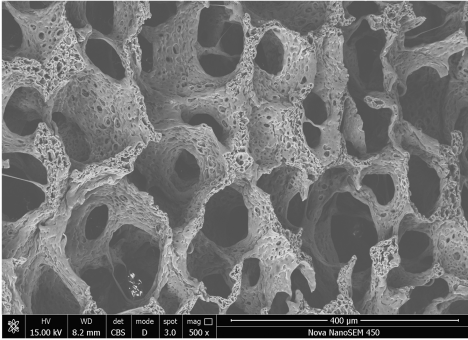Polyvinyl Alcohol Sponge (PVA Sponge)
ANHUI LIWEI CHEMICAL CO.,LIMITED
[Introduction]
We have PVA sponge project with an air foaming process of PVA sponge production, which meets the needs of 5 cubic high quality clean medical PVA sponge per day, which include Nasal dressing, Ear Wick, VAC(Vacuum Assisted Closure) /NWPT PVA Sponge, Expansion Hemostatic PVA Sponge and so on.
INQUITRE NOWTechnical Indicators of Hemostatic Sponge Dressing
Physical Properties:
Absorption rate: Less than 10
seconds
Aperture size : 50-1200 um
Porosity is more than 90%.
Dry absorption ratio is more
than 15
times
Elongation at break is greater
than
120%
Dry density : 0.056-0.10g/cm3
Chemical Properties:
The pH value of leaching
solution is
between 6.5 and 7.8
Formaldehyde
residue is less than
10 PPM
Biological Indicators:
NO SKIN IRRITATION
Packing & Storage
| Packing |
In 20kg paper bag. |
|---|---|
| Storage | Powder 20°C 2 years; Floccule 20°C 2 years. |
| Shipping | Room temperature 5-30℃ in China; may vary elsewhere |
Free Quote
Liwei PVA is one of the top 10 PVA factories and the top 100 strongest enterprises in anhui province.In 2010,Liwei PVA is evaluated as advanced and high technical company. We mainly deals in polyvinyl alcohol,PVA,PVA fiber and raw materials for producing PVA like vinyl acetate.
For samples, pricing, or more information, please call us at 0086-25-52397803 or mail to info@china-pva.net or fill out the following form. We will respond to you as soon as possible.
Tel: 0086-25-52397803
E-mail: info@china-pva.net

Frequently Asked Questions
The PVA sponge is pure white, clean, uniform, comfortable and highly flexible, which can be widely used for PVA expansive hemostatic sponge, Liquid absorbing sponge PVA sponge, Negative Pressure Wound Therapy PVA sponge. The production process is applied by clean gas foaming process and phase separation technology, therefore the PVA sponge shows round and porous bubble shape in microscope by SEM(scanning electron microscope), and the pore wall shows obvious "bubble" characteristics, which is essentially different from the sponge produced by starch filling process. Performances of product such as pore size, density, flexibility and tensile strength could be well controlled.

How is PVA Sponge produced?
Raw material preparation:
After
mixing
PVA and water in a certain
ratio,
the
mixture was
heated to obtain a PVA
aqueous
solution. Next, corn
starch was
added
as a pore-forming
agent, formalin was added
and
stirred,
and then sulfuric acid was
added
as a
catalyst.
Mold procession:
Pour the prepared PVA
material
into
the mold and add the
appropriate
amount of foaming
agent.
Put the mold into the
injection
molding machine.
Use high temperature and
high
pressure
to press the material into
the
required shape, drying
and polishing after
solidification.
What is PVA Sponge used for?
Medical industry: PVA
sponges are
often
used as single-use
surgical
dressings
to absorb
internal exudate during
surgery,
to
support organs and
tissues, and to
fill cavities (e.g.,
nasal passages) to stop
bleeding.
Its sterile provision and
single-use
properties ensure safe and
hygienic
medical
practices.
Industry: PVA sponges are
often
used
in industry for equipment
cleaning
and
maintenance.
Their absorbency and stain
resistance
effectively remove oil,
dust, and
other contaminants
from equipment surfaces.
At the
same
time, PVA sponge also has
anti-static
properties, which
can prevent static
electricity
from
causing damage to
equipment.
Clean room field: PVA
sponges are
widely used in clean rooms
for
cleaning and maintenance.
Their excellent
dust-absorbing and
anti-static properties
effectively
remove particles and
static electricity in the
clean
room,
ensuring its environmental
quality.
Glass and electronic
product
cleaning:
PVA sponges are suitable
for
cleaning
and drying horizontal
glass,
automotive glass, glass
products, printed
substrates, lead
frames, photomasks,
substrates for
liquid crystal
displays, and so on.
It is also suitable for
cleaning
films, plastics, and metal
plates.
Other fields: PVA sponges
can also
be
used to clean and absorb
water
from
tires and mats and
to absorb water adhering
to the
manufacturing process of
food
processing, packaging, and
steaming bag food. In
water-soluble
adhesives, coatings,
static
preventive
agent
humidification, coating
and other
applications, PVA sponge
also
plays an
important role.
How is PVA Sponge packaged and stored?
Packaging: Make sure the
PVA
sponges
are sealed well to prevent
dust
and
other contaminants
from entering. If the
sponge is
unused, it is best to keep
it in
its
original
packaging.
Storage:PVA
sponges
should be stored in a dry
and cool
environment to avoid
moisture. A high-humidity
environment
may cause the sponge to
absorb
water,
deform, or
become moldy, affecting
its
effectiveness.
Avoid contact with
contaminants,
such
as dust, chemicals, etc.,
to avoid
reducing the
cleanliness and
effectiveness of
the
sponge.
What are the safety precautions for the use of PVA Sponges?
PVA sponge itself is non-toxic, odorless, biocompatible, non-irritating to the skin, and biodegradable, making it relatively safe to use. However, it can be contaminated by additives and manufacturing processes during production and use. Factors such as processing or storage conditions can introduce other substances that may be harmful to the human body. Therefore, when using a PVA sponge, please choose a regular brand, follow the instructions for use, and avoid prolonged contact or accidental ingestion. If experiencing any discomfort or abnormal reaction during use, seek medical advice immediately and consult a healthcare professional.
400 Micron Scanning Electron Microscope Picture Benefits
1.No fiber and crumbs will
drop
during
surgery, no
reinfection.
2.Soft, comfortable &
painless.
3.Instantly liquid
absorption
ability
and the absorption is
10-18 times
its
weight.
4.Stops nose bleeding
fast,
absorbs
wound exudates
massively.
5.Moist dressing, no
second damage
upon removal.
6.Better biocompatibility
and no
rejection reaction.
7.Highly swelled after
absorbing
liquid, form
micro-negative
pressure
which is beneficial to
wound healing






